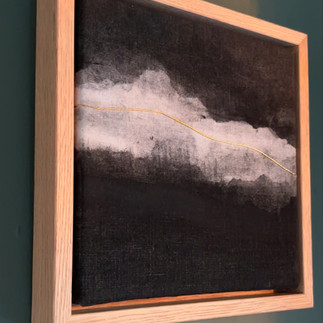How do you name prints and create titles for earth pigment textiles? What is the Name Nursery?
- Su France
- Mar 25
- 4 min read
Updated: Mar 26
A Name Nursery: Cultivating Art Titles
Sowing the title Seeds

I affectionately call my digital list of potential names for the textiles and prints I create the 'Name Nursery.'
This obviously isn't a physical garden (its much easier to tend, but and I have less need of a shower to relieve my back afterwards, but rather its a curated collection of potential titles—phrases, words, and ideas waiting to be paired with the right creation.

Like seedlings requiring the right conditions to flourish, these titles need time to develop before they find their forever home on a gallery wall.
Some are sparked by conversations overheard in coffee shops, others emerge from favourite books or music, and many simply germinate during quiet moments.
They get recorded in my dedicated digital notebook, where they may later be crossed off after use or remain for a longer growth period.

The Organic Growth Process
Sometimes, titles arrive before the artwork itself exists. During my research phase, while I'm gathering reference materials or exploring concepts in my 'head sketchbook', a phrase might suddenly appear that perfectly sums up what I aim to create. This happened with some of my 'Finding peace in the rain' works.
Other times, titles emerge organically during the creation process—an inky colour combination unexpectedly suggests the perfect words. I've found that allowing these titles to develop naturally, without forcing them, results in names that truly enhance the viewing experience. Occasionally titles take their own sweet time to arrive and it is then my list comes into its own.

Like plants requiring different growing conditions, some titles mature quickly while others need months of consideration before they're ready to be 'harvested'. I highlight them when used and have now added categories such as 'ceramics', the 'elements' etc so I can find the most suitable titles for a work.
The three photos below- a reflection in our barn window (with a double exposure quality), a huge storm approaching across our field and the red line in the dramatic sky by one of our 'we're home' trees. All of these moments helped to trigger titles to be added to the Name Nursery!
You can make up your own as to what they might be.
Pruning and Transplanting
Not every title finds its forever home. Some wither away, while others prove too generic or forced. The pruning process is essential—I regularly review my collection, refining words, combining concepts, and occasionally removing titles that no longer resonate.
I tend to work in themes whether through stitch or earth pigment and earlier last year many storms raged through my work and their titles reflected...
Nurturing the Name
A well-chosen title can extend the conversation between artist and viewer, which also for me means that the wrong title can jar, derail or even stop a dialogue. I've discovered that titles placed in my Name Nursery form deeper connections with their eventual artworks than hastily assigned names. They carry with them the benefit of consideration, like slow-grown organic produce compared to mass-produced alternatives.
Then there are times when I go with something simple. Sometimes titles are simply descriptive, perhaps linking to where a flower or earth pigment was found, as they were last week for these simple intaglio flower prints, which had names such as By the Gate, Up the Lane and Flowers from the Meadow, held up to them to see if they might 'fit.'
A Lesson from Grayson Perry: Viewing Art Differently
Years ago, I attended an exhibition of Grayson Perry's tapestries, "The Vanity of Small Differences." While an enthusiastic usher tried to guide visitors through the narrative, I chose a different approach. I deliberately viewed the exhibition in reverse, allowing myself to form unfiltered impressions.
This experience taught me a crucial lesson about art and interpretation. I now approach both creating and viewing art with a similar philosophy—allowing the initial, raw experience to speak before consulting titles or descriptions.
Emotional responses, discovering connections, and creating stories
In other exhibitions, standing before a piece, I allow my initial impressions to form uninfluenced—noting emotional responses, discovering connections, and building my own narrative around what I'm seeing. Only after this personal communion with the art do I finally step closer to read the title and artist's notes and sometimes I pass on this part. This moment sometimes brings a collision between my interpretation and the artist's intention—sometimes revealing surprising alignments, other times creating fascinating contradictions. I find this approach preserves my first reaction while adding an additional layer of discovery. I think its why at fairs and exhibitions I may ask someone buying a piece of art, why they have chosen it.

Conversations with the artist, even when they're not present.
The title of artwork becomes not an instruction for viewing but rather a conversation , offering a second perspective that either confirms, challenges, or expands my initial understanding. On my own piece, 'Honouring Fragments,' without explicitly saying the work links to the Japanese philosophy and tradition of Kintsugi, the title informs the viewer of not only the craft, but my attitude to it.
What about you?
Do you have your own version of a "Name Nursery" for your creative projects?
How important are titles to your experience of art?
Do they enhance your understanding or sometimes feel like an unnecessary addition?Perhaps you collect potential names for paintings, titles for stories, or even names for characters or businesses? I'd love to hear how you capture and nurture your ideas before they find their final home.
Or, if you're a fellow artist, do your titles come before, during, or after the creation process? Or if youre an art collector are the titles of any importance to you? Do they need to resonate too?





























Comments